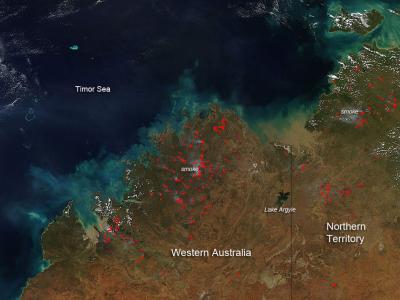In Western Australia, the wet season occurs between December and March and the dry season between May and October. The reversals of prevailing winds in the two season drives the shift from wet to dry and back.
In April and May, fires usually burn themselves out within a few days due to the fact that even though there are dry spots that may catch fire, the wet area around them will keep the fires from burning out of control. The worst time for fire is late in the dry season, when vegetation has dried to tinder and blazes tend to be uncontrollable, intense, and dangerous.
The Moderate Resolution Imaging Spectroradiometer (MODIS) on NASA's Aqua satellite acquired this image of dozens of fires in both Western Australia and the Northern Territory on April 28, 2013.

In Western Australia, the wet season occurs between December and March and the dry season between May and October. The reversals of prevailing winds in the two season drives the shift from wet to dry and back.
(Photo Credit: NASA image courtesy Jeff Schmaltz LANCE/EOSDIS MODIS Rapid Response Team, GSFC. Caption by Adam Voiland and Lynn Jenner)
Although smoke plumes are visible, MODIS actually detects the fires by sensing thermal infrared energy radiating from the land surface. The heat is invisible in images like this, but the locations where MODIS detected fire are labeled with red outlines.
Prescribed burns in this area are part of a program managed by the Australian government and by conservation groups. The Ecofire effort, ongoing since 2007, has the goal of reducing destructive late-season out of control fires by increasing the number of early-season fires. The early fires tend to burn in a patchwork pattern that makes it easier for vegetation to reestablish itself afterwards.
As traditional lifestyles have been replaced by modern ways of living, the number of early season fires has decreased and the number of destructive, later fires has increased. The intent of Ecofire is to return the landscape to a burning regime that mirrors what happened in the past. For tens of thousands of years, aboriginal people in the region engaged in a practice known as "fire-stick farming." People intentionally lit fires in the early-season to encourage the growth of grasslands and to make it easier to locate and track animals for hunting.
Source: NASA/Goddard Space Flight Center